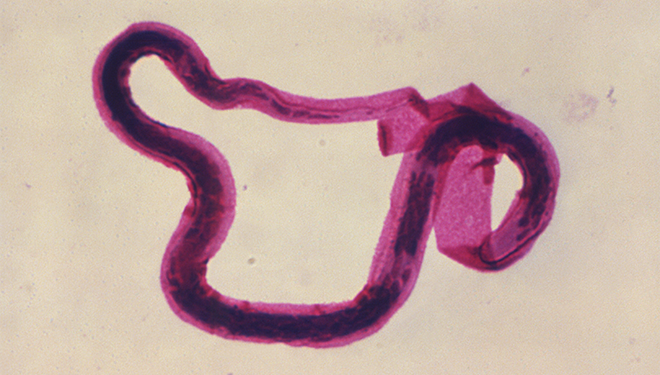Key points
- Lymphatic filariasis is a disease caused by microscopic parasitic worms.
- Most people have no symptoms, but in others it can cause arms, legs, breasts, or genitals to swell.

Overview
Lymphatic filariasis, sometimes called LF, is a disease caused by an infection with thread-like parasitic worms. A parasite is an organism (a living thing) that lives on or inside another organism. It can cause severe swelling in the legs and other parts of the body. You can get lymphatic filariasis from a bite of an infectious mosquito. The best way to prevent lymphatic filariasis is to avoid mosquito bites.
Lymphatic filariasis is considered a neglected tropical disease (NTD) because it inflicts tremendous disability and illness among the affected populations in impoverished communities. People in affected communities often lack access to basic or adequate resources, like medical care or sanitation. Safe and effective medicines can control many NTDs through mass drug administration (MDA) programs in the affected communities.
Symptoms
Most people infected with the worms that cause lymphatic filariasis never show symptoms. Others may not develop symptoms until several years after infection. But for those who do, the signs and symptoms of lymphatic filariasis may include
- Lymphedema, a swelling of the legs (severe cases are sometimes known as elephantiasis), arms, breasts, or genitalia.
- Hydrocele, or swelling in the scrotal sac, usually of adult men.
- Hardening or thickening of skin.
- Persistent coughing, wheezing, or shortness of breath.
- Bacterial infections of the skin or lymph system.
Some of these symptoms occur many months or even years after initial infection with the parasite.
Risk factors
Lymphatic filariasis rarely occurs in casual travelers. Unlike malaria, it takes repeated bites from infectious mosquito for people to become infected. Travelers to at-risk areas are most likely to become infected if they stay in these areas for long periods of time, such as missionaries, Peace Corps volunteers, or field researchers.
You are more likely to get lymphatic filariasis if you
- Live in a tropical or sub-tropical country where parasitic worms are common.
- Get repeated mosquito bites over several months or years in these places.
How it spreads
Mosquitoes spread lymphatic filariasis from one person to another. When a mosquito bites a person who has lymphatic filariasis, microscopic worms in the person's blood enter and infect the mosquito. When the infectious mosquito bites another person, that person may be infected and the cycle of spreading lymphatic filariasis continues.
Prevention
The best way to prevent lymphatic filariasis is to avoid mosquito bites.
- Avoid areas with high mosquito activity, especially between dusk and dawn. Mosquitoes that carry the parasite that causes lymphatic filariasis usually bite at night.
- Use Environmental Protection Agency (EPA)-registered insect repellents containing DEET or another EPA-registered active ingredient.
- Wear loose-fitting, long-sleeved shirts and pants and socks.
- Keep windows and doors closed or covered with screens to keep mosquitoes out of your house.
- Repair broken screens on windows, doors, porches, and patios.
Diagnosis
To diagnose lymphatic filariasis, a healthcare provider will examine a small sample of your blood under a microscope to identify the microscopic worms, called microfilariae.
They may also use a test that looks for antibodies your immune system produces if you are infected.
Treatment
The usual treatment for lymphatic filariasis is a drug called diethylcarbamazine (DEC), which kills both immature and adult worms. Healthcare providers can obtain DEC from CDC after lab results confirm infection. DEC can help treat recent infections; however, it is not helpful in treating chronic symptoms related to damage of the lymphatic system (e.g., elephantiasis, hydrocele) that might remain many years after initial infection.
See your healthcare provider for diagnosis of and treatment for lymphatic filariasis.
